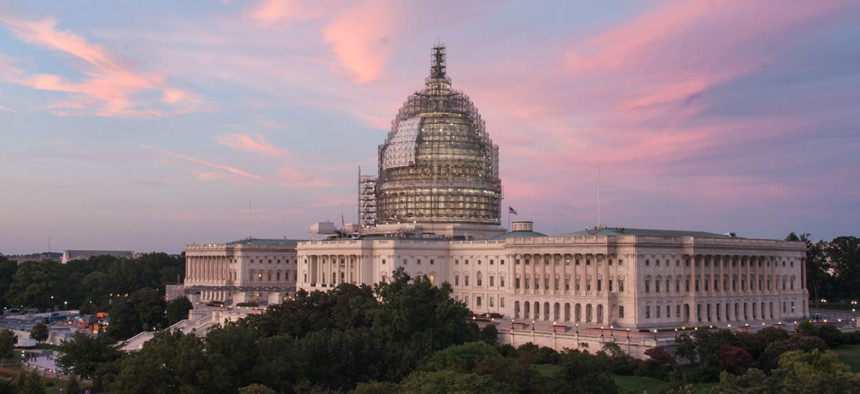
Architect of the Capitol
Look for Lawmakers to Again Target Feds’ Benefits
Democrat vows fight, calls using federal workers as offsets for other costs ‘unconscionable.’
Amid all the tumult in the House, Congress still faces a series of deadlines and must-pass bills, and federal employees' pay and benefits could once again be on the chopping block.
The date foremost on the minds of federal workers is Dec. 11, when the current stopgap funding measure will expire and Congress must once again act to stave off a government shutdown. Leaders on Capitol Hill are currently engaged in budget negotiations to lift sequester caps and set top-line spending levels. But in order to raise the funding for federal agencies above the anemic levels created by the 2011 Budget Control Act, lawmakers and President Obama must agree on ways to offset the costs.
In 2013, Rep. Paul Ryan, R-Wis., and Sen. Patty Murray, D-Wash., agreed to break sequester caps in fiscal 2014 and 2015. To offset those expenses, the Ryan-Murray budget deal -- among other provisions -- raised the amount that new federal employees must contribute to their pension funds to 4.4 percent of their paychecks. Initially, Republicans fought to apply the change to current feds, but Democrats successfully fended off that effort.
“We have made sure current federal employees have not been harmed by previous efforts,” Rep. Chris Van Hollen, D-Md., the lead Democrat on the House Budget Committee who has been involved in the budget negotiations for the last several years, said in an interview with Government Executive.
This time around, however, there are once again calls to apply those changes to the entire civilian workforce.
The Committee for a Responsible Federal Budget last month unveiled a “sequester offset plan,” identifying an array of proposals to pay for the $110 billion cost of eliminating sequester caps for two years. The suggestions included applying a 1.3 percent pension contribution hike across the board to all current federal workers. The change would result in anyone hired after 2012 paying 4.4 percent of their salaries toward their defined benefit and employees hired before then contributing 2.1 percent. The effective federal pay cut would save $20 billion over 10 years, CRFB estimated.
Edward Lorenzen, senior analyst at CRFB, said under the proposal the increased rate would be phased in over time. It would not increase more than the annual pay increase for federal employees, Lorenzen explained, “so there would not be a net reduction in take home pay.”
Van Hollen said he expected the proposal to once again come up in the talks for a new budget deal, citing the precedent he has seen in recent negotiations.
“In every case, the Republicans have put federal employees on the chopping block, Van Hollen said. Still, he vowed Democrats would not budge: “We will protect federal employees.”
The long-time federal employee advocate and 2016 Senate candidate called it ironic that Republicans consistently go after feds, as they “want the federal government to be there” whenever something goes wrong for one of their constituents.
“It’s unconscionable that Republicans would once again come after federal employees who are working hard to provide public services,” he said.
CRFB, a bipartisan group, noted there is more than one way to skin the cat of offsetting sequester costs. In an alternate proposal, the committee suggested reforming the pension benefit formula so it accounts for the five highest paid years a federal employee worked, instead of the current system of averaging the three highest. That change to the Federal Employees Retirement System would save $5 billion over 10 years, CRFB estimated.
The group also suggested that lawmakers could bring back a proposal first floated by House Republicans in their fiscal 2016 budget to provide a less generous return to federal employees and retirees enrolled in the Thrift Savings Plan's government securities (G) Fund. Lorenzen pointed to the GOP proposal that determined G Fund participants “are rewarded with a long-term rate on what is essentially a short-term security.” That change would save $30 billion over 10 years, according to CRFB.
Senate Republicans briefly floated reducing the G Fund’s rate of return as part of an offset to pay for an extension of highway funding, but the plan was ultimately scrapped. Lawmakers must once again must deal with the Highway Trust Fund by the end of October, raising the possibility the proposal could be brought back. Congress must raise or suspend the debt ceiling by early November, the showdown that brought on the sequester in the first place in 2011. On top of those deadlines is the annual concern of extending a series of tax breaks, though Congress has recently declined to fully offset those costs.
So if federal employees avoid being targeted in any one of these deadlines, there will still be another one looming right around the corner. It could prove difficult for feds to escape all of these events unscathed.
“We are getting into an issue where various offsets are the same ones,” said Shai Akabas, the associate director for economic policy at the Bipartisan Policy Center.
NEXT STORY: We’ll Find Out Oct. 15 If There’s a 2016 COLA







